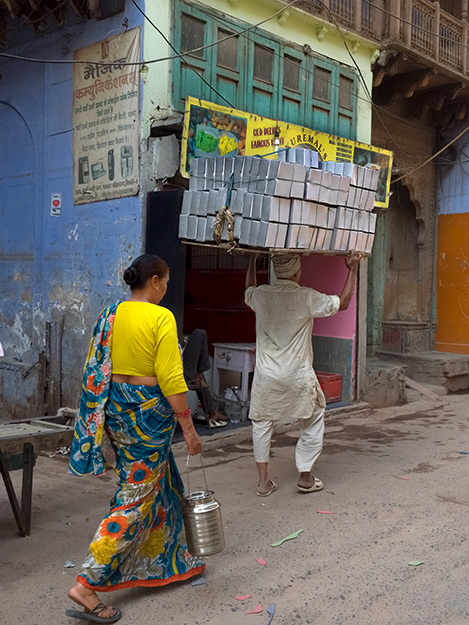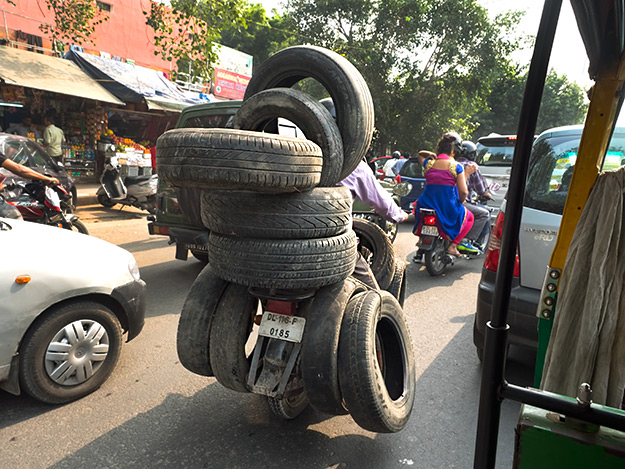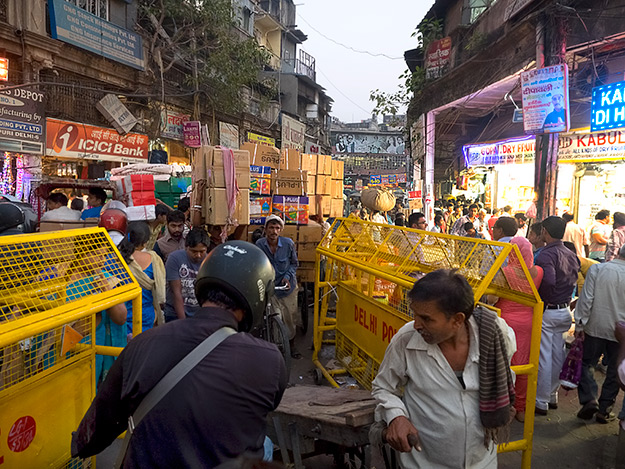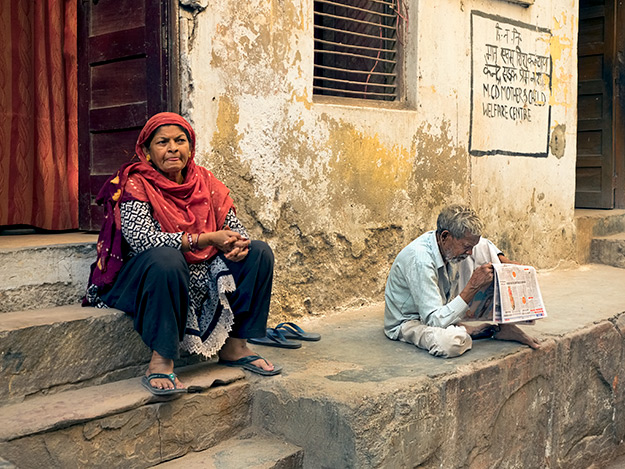The bus braked suddenly, jolting me awake. I blinked rapidly, trying to reconcile the scene outside my window. Somewhere between Agra and Delhi, India, hundreds of sheep crossing the highway had brought us to a dead stop. Slender women draped from head to toe in black gauze walked gracefully among the animals, prodding them with wooden staffs. Ever so slowly, the bleating flock meandered to the opposite side and we resumed our journey.

I was amused but not surprised. After eight days in Delhi, nothing shocked me. Raw sewage ran down the center of dirt lanes where houses had no access to water or proper sanitation. Women sat by the roadside pounding cow and buffalo dung into patties for use as fuel and fertilizer. Men urinated against walls in public places. Carry-wallahs toted enormous loads on their backs from one end of the city to another. And everywhere, every moment, men hawked food and merchandise from Lilliputian storefronts that lined the roads.

What did surprise me was how quickly I adapted to India. Initially, I was wide-eyed at the sheer mass of humanity. On my second day, my hosts at Prakash Kutir B&B took me to visit their lace manufacturing factory. Six lanes of traffic choked the three-lane highway, with no one paying the least attention to lines painted on the asphalt. When I remarked about it, Sagar replied, “Oh, lanes are only there for the few foolish drivers who choose to pay attention to them.” I later learned that there is no such thing as driver’s education in India. Young men (and increasingly, women) teach themselves to drive. There is also no formal driver’s licensing process. Most people simply pay a bribe to be issued a license, which explains why all vehicles, from the oldest moto-rickshaw to the newest luxury Mercedes, are scraped and dented.

A few days later, when a motorcycle laden down with three compete sets of car tires whizzed past my moto-rickshaw, I didn’t even blink. One evening in Old Delhi, I got caught in a crush of shoppers making last minute purchases for the Hindu festival of Diwali. Eager to escape the crowd, I headed for the opposite side of the road. Halfway across, I was trapped between yellow metal police barriers that funneled pedestrians into a narrow gap.

Torrents of traffic hurtled by in front of me. Behind me, a tsunami of people piled up. Suddenly, a motorbike roared up and bullied its way into the narrow pedestrian area. The biker abruptly turned left in front of me and got stuck on a low metal barrier separating the lanes. Over and over he revved the engine, trying to force his way across. Vendors with pushcarts inserted themselves into the fray and shoved past the paralyzed biker. I looked up from his spinning wheels and realized that a cycle rickshaw carrying a mountain of teetering boxes was bearing down on us. Instinctively, I grabbed the back seat of the motorbike and shoved. Three more people joined in and with one last roar, he was up and over. I scampered through the Gordian traffic knot to the other side of the road…and never gave it another thought.

By the time I departed from Delhi India, my wide-eyed wonder had evaporated into the ether. Workers sitting cross-legged in the street, waiting to be hired for the day, seemed normal. Motorcycles whizzing by with inches to spare no longer made me jump. I stopped squirming whenever women in exquisite silk saris walked blindly past beggars with stumps for legs. Even the buffalo and cows that roamed the streets ceased to startle me. As I sat in that bus on my way to Agra, I marveled over the human capacity to adapt and survive, even in the most challenging of circumstances. Little wonder, then, that a herd of sheep blocking the highway seemed humdrum.

Disclosure: I was a guest of Prakash Kutir B&B during my visit to Delhi. However, the receipt and acceptance of complimentary items or services will never influence the content, topics, or posts in this blog. I write the truth, the whole truth, and nothing but the truth. They truly are an exemplary B&B/Homestay in Delhi.

Love this place. I would love to explore it every time.
Hi Alice: India is definitely an experience that is different from anywhere else on the planet. Hope you get to go.
Barbara
Great article, thanks.
I visited with my teenage children August 2016 as I had always wanted them to experience the country.
I am 60, and had lived in Delhi for a few years as a teenager, as my father worked there.
Unfortunately, despite booking 10 days at a lovely hotel, visiting old haunts and doing the touristy trips, I felt really uncomfortable anywhere in the city even when being taking round by hotel car and driver.
I terminated my trip early, returning home after 7 days. The children were not particularly pleased as they loved it – as I did as a teenager – but accepted my extreme discomfort.
I still wonder why I felt as bad as I did, even beginning to despise the populace. My resentment was borne of the fact that so many problems were caused by the poverty and the caste system. Perhaps it was an age thing?
So many of the statements in your article really resonated with me. Thanks.
Hi Paddy: I hear you. India can be overwhelming and exhausting. For some it is just so much sensory overload that they can’t handle it. I spend so much time in Asia that I’ve become inured to the garbage and noise, and teeming millions of humans. And once you get past all that, you can connect with the true India, the spiritual side, the underbelly, which allows you to understand how they can cope. I believe it is their faith and the way it makes them accept the world. The concepts of karma and reincarnation explain why they have been given the life they are living, and their faith allows them to accept it.
I stumbled on this by sheer chance. Liked what I saw and read. Fact is sensory overload is a very polite way of putting it. Actually Delhi is overwhelming. The crowds, vehicles. people, billboards- the numbers can leave you gasping. No offense to Delhiwalas. Am one of them!
LOL -you’re right, Deepak. It’s overwhelming and indescribable. And I loved it. Thanks so much for your comment.
The title of the article matches the pictures perfectly. Sensory overload is something that I think and write about a lot. Your writing paints a great visual for me.
Thanks so much Ryan! I try to invoke the senses when I write – the sights, smells, sounds, etc. Glad to hear I was successful in this case.
i wrote to you earlier in January, saying howI wanted to go to India, but with no idea why!! Reading this blog, I still don’t know, but I still want to go. reading your blogs is a good honest way to build SOME expectation, yes, everyone has said “you’ll never be ready, you’ll have no idea just how noisy, dirty, smelly, etc” it is, I don’t care, the more I read, the more the need grows to go…… thank you, please continue to write, and inspire 🙂
Great writing, I was there with you! It’s true the senses get accustomed quickly to the onslaught of colors, noises and smells of Delhi. It took my mind longer to reconcile the glaring inequalities there. I’ve seen poverty elsewhere but when great wealth and crippling poverty exist in such proximity the mind can’t help but focus on the disparity. Holding those two realities forever changed me.
Thanks so much Evelyn. Saying that you were there with me is the highest praise you can offer to any writer, and I appreciate you taking the time to leave a comment.
Thank you so much Fiona. It means a great deal to me when I hear that my writing and photography inspires others to travel. Hope you make it to India. It is definitely a life-changing experience.